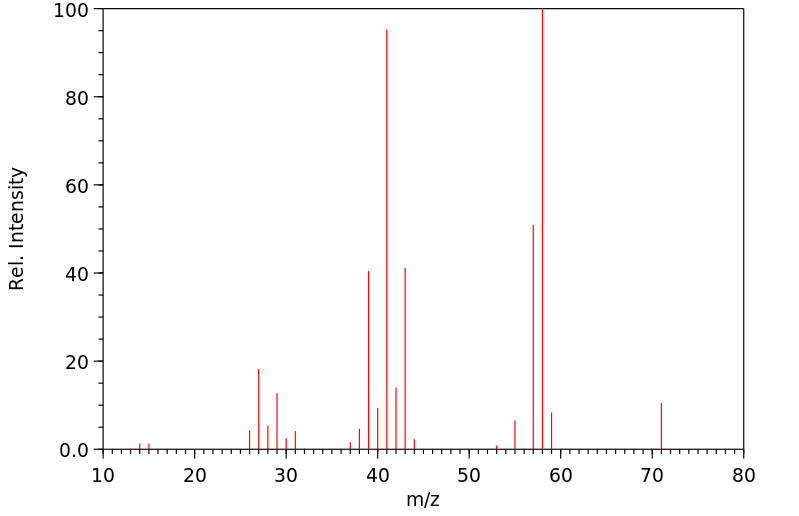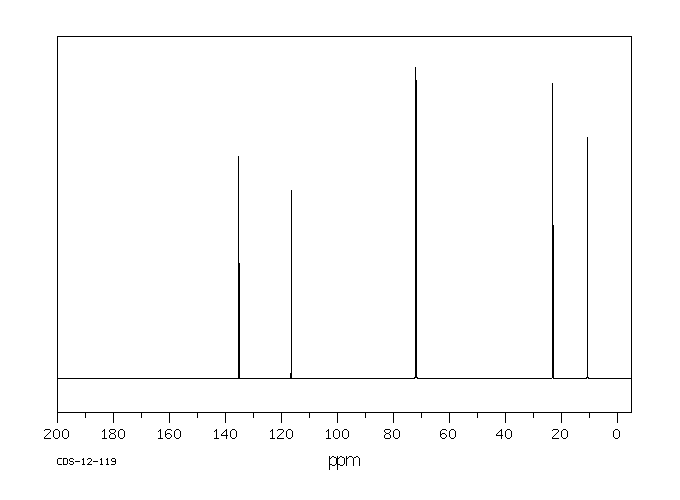烯丙基正丙酯 | 1471-03-0
中文名称
烯丙基正丙酯
中文别名
烯丙基丙酯;烯丙基丙基醚
英文名称
allyl propyl ether
英文别名
propyl allyl ether;3-propoxyprop-1-ene;1-Propene, 3-propoxy-;1-prop-2-enoxypropane
CAS
1471-03-0
化学式
C6H12O
mdl
MFCD00009375
分子量
100.161
InChiKey
LWJHSQQHGRQCKO-UHFFFAOYSA-N
BEILSTEIN
——
EINECS
——
-
物化性质
-
计算性质
-
ADMET
-
安全信息
-
SDS
-
制备方法与用途
-
上下游信息
-
文献信息
-
表征谱图
-
同类化合物
-
相关功能分类
-
相关结构分类
物化性质
-
熔点:-105.33°C (estimate)
-
沸点:90-92 °C(lit.)
-
密度:0.767 g/mL at 25 °C(lit.)
-
闪点:23 °F
-
蒸汽压力:60.76 mmHg
-
稳定性/保质期:
如果按照规格使用和储存,一般不会发生分解,也未有已知的危险反应。应避免与氧化物接触。
计算性质
-
辛醇/水分配系数(LogP):1.6
-
重原子数:7
-
可旋转键数:4
-
环数:0.0
-
sp3杂化的碳原子比例:0.666
-
拓扑面积:9.2
-
氢给体数:0
-
氢受体数:1
安全信息
-
危险等级:3.1
-
危险品标志:F,Xi
-
安全说明:S16,S26,S36/37/39
-
危险类别码:R11
-
WGK Germany:3
-
危险品运输编号:UN 3271 3/PG 2
-
海关编码:2909199090
-
包装等级:II
-
危险类别:3.1
-
储存条件:请将贮藏器密封,并将其存放在阴凉、干燥的地方。确保工作区域有良好的通风或排气设施。
SDS
| Name: | Allyl propyl ether Material Safety Data Sheet |
| Synonym: | Non |
| CAS: | 1471-03-0 |
Synonym:Non
Section 2 - COMPOSITION, INFORMATION ON INGREDIENTS
| CAS# | Chemical Name | content | EINECS# |
| 1471-03-0 | Allyl propyl ether | 100.0 | unlisted |
Risk Phrases: 11 36/37/38
Section 3 - HAZARDS IDENTIFICATION
EMERGENCY OVERVIEW
Highly flammable. Irritating to eyes, respiratory system and skin.The toxicological properties of this material have not been fully investigated.
Potential Health Effects
Eye:
Causes eye irritation.
Skin:
Causes skin irritation.
Ingestion:
May cause gastrointestinal irritation with nausea, vomiting and diarrhea. The toxicological properties of this substance have not been fully investigated.
Inhalation:
Causes respiratory tract irritation. Vapors may cause dizziness or suffocation.
Chronic:
No information found.
Section 4 - FIRST AID MEASURES
Eyes: Immediately flush eyes with plenty of water for at least 15 minutes, occasionally lifting the upper and lower eyelids. Get medical aid.
Skin:
Get medical aid. Flush skin with plenty of water for at least 15 minutes while removing contaminated clothing and shoes. Wash clothing before reuse.
Ingestion:
Never give anything by mouth to an unconscious person. Get medical aid. Do NOT induce vomiting. If conscious and alert, rinse mouth and drink 2-4 cupfuls of milk or water.
Inhalation:
Remove from exposure and move to fresh air immediately. If not breathing, give artificial respiration. If breathing is difficult, give oxygen. Get medical aid.
Notes to Physician:
Treat symptomatically and supportively.
Antidote: None reported.
Section 5 - FIRE FIGHTING MEASURES
General Information:
As in any fire, wear a self-contained breathing apparatus in pressure-demand, MSHA/NIOSH (approved or equivalent), and full protective gear. Vapors may form an explosive mixture with air.
Vapors can travel to a source of ignition and flash back. During a fire, irritating and highly toxic gases may be generated by thermal decomposition or combustion. Will burn if involved in a fire. Use water spray to keep fire-exposed containers cool. Containers may explode in the heat of a fire. Flammable liquid and vapor. Vapors may be heavier than air. They can spread along the ground and collect in low or confined areas.
Extinguishing Media:
For small fires, use dry chemical, carbon dioxide, water spray or alcohol-resistant foam. For large fires, use water spray, fog, or alcohol-resistant foam. Use water spray to cool fire-exposed containers. Water may be ineffective. Do NOT use straight streams of water.
Section 6 - ACCIDENTAL RELEASE MEASURES
General Information: Use proper personal protective equipment as indicated in Section 8.
Spills/Leaks:
Absorb spill with inert material (e.g. vermiculite, sand or earth), then place in suitable container. Clean up spills immediately, observing precautions in the Protective Equipment section. Sweep up or absorb material, then place into a suitable clean, dry, closed container for disposal. Remove all sources of ignition. Use a spark-proof tool. Provide ventilation. A vapor suppressing foam may be used to reduce vapors.
Section 7 - HANDLING and STORAGE
Handling:
Wash thoroughly after handling. Remove contaminated clothing and wash before reuse. Ground and bond containers when transferring material. Use spark-proof tools and explosion proof equipment. Avoid contact with eyes, skin, and clothing. Empty containers retain product residue, (liquid and/or vapor), and can be dangerous. Keep container tightly closed. Keep away from heat, sparks and flame.
Avoid ingestion and inhalation. Use with adequate ventilation. Wash clothing before reuse. Do not pressurize, cut, weld, braze, solder, drill, grind, or expose empty containers to heat, sparks or open flames.
Storage:
Keep away from heat, sparks, and flame. Keep away from sources of ignition. Store in a tightly closed container. Store in a cool, dry, well-ventilated area away from incompatible substances.
Flammables-area.
Section 8 - EXPOSURE CONTROLS, PERSONAL PROTECTION
Engineering Controls:
Facilities storing or utilizing this material should be equipped with an eyewash facility and a safety shower. Use adequate ventilation to keep airborne concentrations low.
Exposure Limits CAS# 1471-03-0: Personal Protective Equipment Eyes: Wear appropriate protective eyeglasses or chemical safety goggles as described by OSHA's eye and face protection regulations in 29 CFR 1910.133 or European Standard EN166.
Skin:
Wear appropriate protective gloves to prevent skin exposure.
Clothing:
Wear appropriate protective clothing to prevent skin exposure.
Respirators:
A respiratory protection program that meets OSHA's 29 CFR 1910.134 and ANSI Z88.2 requirements or European Standard EN 149 must be followed whenever workplace conditions warrant respirator use. Follow the OSHA respirator regulations found in 29 CFR 1910.134 or European Standard EN 149. Use a NIOSH/MSHA or European Standard EN 149 approved respirator if exposure limits are exceeded or if irritation or other symptoms are experienced.
Section 9 - PHYSICAL AND CHEMICAL PROPERTIES
Physical State: Liquid
Color: colorless
Odor: Not available.
pH: Not available.
Vapor Pressure: Not available.
Viscosity: Not available.
Boiling Point: 90 - 92 deg C
Freezing/Melting Point: Not available.
Autoignition Temperature: Not available.
Flash Point: -4 deg C ( 24.80 deg F)
Explosion Limits, lower: Not available.
Explosion Limits, upper: Not available.
Decomposition Temperature:
Solubility in water:
Specific Gravity/Density: .7670g/cm3
Molecular Formula: C6H12O
Molecular Weight: 100.16
Section 10 - STABILITY AND REACTIVITY
Chemical Stability:
Stable at room temperature in closed containers under normal storage and handling conditions.
Conditions to Avoid:
Incompatible materials, ignition sources, excess heat.
Incompatibilities with Other Materials:
Strong oxidizing agents, strong acids.
Hazardous Decomposition Products:
Carbon monoxide, carbon dioxide.
Hazardous Polymerization: Has not been reported
Section 11 - TOXICOLOGICAL INFORMATION
RTECS#:
CAS# 1471-03-0 unlisted.
LD50/LC50:
Not available.
Carcinogenicity:
Allyl propyl ether - Not listed by ACGIH, IARC, or NTP.
Section 12 - ECOLOGICAL INFORMATION
Section 13 - DISPOSAL CONSIDERATIONS
Dispose of in a manner consistent with federal, state, and local regulations.
Section 14 - TRANSPORT INFORMATION
IATA
Shipping Name: FLAMMABLE LIQUID, N.O.S.*
Hazard Class: 3
UN Number: 1993
Packing Group: II
IMO
Shipping Name: FLAMMABLE LIQUID, N.O.S.
Hazard Class: 3.2
UN Number: 1993
Packing Group: II
RID/ADR
Shipping Name: FLAMMABLE LIQUID, N.O.S.
Hazard Class: 3
UN Number: 1993
Packing group: II
Section 15 - REGULATORY INFORMATION
European/International Regulations
European Labeling in Accordance with EC Directives
Hazard Symbols: XI F
Risk Phrases:
R 11 Highly flammable.
R 36/37/38 Irritating to eyes, respiratory system
and skin.
Safety Phrases:
S 9 Keep container in a well-ventilated place.
S 16 Keep away from sources of ignition - No
smoking.
S 26 In case of contact with eyes, rinse immediately
with plenty of water and seek medical advice.
S 33 Take precautionary measures against static
discharges.
S 37/39 Wear suitable gloves and eye/face
protection.
WGK (Water Danger/Protection)
CAS# 1471-03-0: No information available.
Canada
CAS# 1471-03-0 is listed on Canada's NDSL List.
CAS# 1471-03-0 is not listed on Canada's Ingredient Disclosure List.
US FEDERAL
TSCA
CAS# 1471-03-0 is listed on the TSCA inventory.
SECTION 16 - ADDITIONAL INFORMATION
N/A
上下游信息
-
上游原料
中文名称 英文名称 CAS号 化学式 分子量 烯丙基醚 Allyl ether 557-40-4 C6H10O 98.1448
反应信息
-
作为反应物:参考文献:名称:一个位置上的立体选择性烯烃异构化摘要:尽管在烯烃异构化中控制双键的位置和 E:Z 选择性很困难,但 1 是一种非常有效的催化剂,可用于多种多功能烯烃的选择性单异构化,以提供 >99.5% 的 E 产物。许多反应在室温下 10 分钟内完成。甚至可以生成对进一步反应敏感的敏感烯醇和烯酰胺。可以使用 0.01-0.1 mol% 范围内的催化剂负载量。二烯丙基醚产物的 E-to-Z 异构化速度仅为其形成速度的 <10(-6) 倍,显示出极高的动力学选择性 1。DOI:10.1021/ja3036477
-
作为产物:描述:magnesium n-propoxide 、 3-溴丙烯 反应 48.0h, 以94%的产率得到烯丙基正丙酯参考文献:名称:由相应的烷氧基镁合成苄基/烯丙基烷基醚摘要:在碘的存在下,醇与镁反应生成烷氧基镁,然后将其用苄基氯或烯丙基溴处理以生成苄基烷基醚或烯丙基烷基醚。DOI:10.1016/0040-4039(96)01046-5
文献信息
-
Novel lincomycin derivatives possessing antimicrobial activity申请人:Lewis G. Jason公开号:US20050043248A1公开(公告)日:2005-02-24Novel lincomycin derivatives are disclosed. These lincomycin derivatives exhibit antibacterial activity. The compounds of the subject invention may exhibit potent activities against bacteria, including gram positive organisms, and may be useful antimicrobial agents. Methods of synthesis and of use of the compounds are also disclosed.
-
[EN] INHIBITORS OF HUMAN IMMUNODEFICIENCY VIRUS REPLICATION<br/>[FR] INHIBITEURS DE LA RÉPLICATION DU VIRUS DE L'IMMUNODÉFICIENCE HUMAINE申请人:BOEHRINGER INGELHEIM INT公开号:WO2009062288A1公开(公告)日:2009-05-22The present invention relates to compounds of formula (I) wherein c, X, Y, R2, R3, R4 and R6 are as defined herein, compositions and uses thereof for treating human immunodeficiency virus (HIV) infection. In particular, the present invention provides novel inhibitors of HIV integrase, pharmaceutical compositions containing such compounds and methods for using these compounds in the treatment of HIV infection本发明涉及式(I)的化合物,其中c、X、Y、R2、R3、R4和R6如本文所定义,以及用于治疗人类免疫缺陷病毒(HIV)感染的组合物和用途。具体地,本发明提供了HIV整合酶的新型抑制剂,含有这些化合物的药物组合物以及在治疗HIV感染中使用这些化合物的方法
-
Defined Palladium–Phthalimidato Catalysts for Improved Oxidative Amination作者:Claudio Martínez、Kilian MuñizDOI:10.1002/chem.201601128日期:2016.5.23New palladium(II)–phthalimidato complexes have been synthesized, isolated, and structurally characterized. As demonstrated from over 30 examples, they constitute superior catalysts for oxidative amination reactions of alkenes with phthalimide as the nitrogen source. This work streamlines vicinal difunctionalization of alkenes and provides access to significantly improved and experimentally simplified
-
Ionic-Liquid-Promoted Decaborane Olefin-Hydroboration: A New Efficient Route to 6-R-B<sub>10</sub>H<sub>13</sub> Derivatives作者:Upal Kusari、Patrick J. Carroll、Larry G. SneddonDOI:10.1021/ic801000c日期:2008.10.20transition metal catalysts are required, decaborane olefin-hydroboration reactions have been found to proceed in biphasic ionic-liquid/toluene mixtures with a wide variety of olefins, including alkyl, alkenyl, halo, phenyl, ether, ester, pinacolborane, ketone, and alcohol-substituted olefins, and these reactions now provide simple high-yield routes to 6-R-B10H13 derivatives. Best results were observed for reactions与需要过渡金属催化剂的常规有机溶剂不同,十硼烷烯烃加氢硼化反应已在含有多种烯烃的双相离子-液体/甲苯混合物中进行,包括烯烃,烷基,烯基,卤素,苯基,醚,酯,频哪醇硼烷,酮和醇取代的烯烃,现在这些反应为6-R-B10H13衍生物提供了简单的高产率途径。观察到与bmimX(1-丁基-3-甲基咪唑鎓,X = Cl(-)或BF4(-))和bmpyX(1-丁基-4-甲基吡啶鎓,X = Cl(-)或 (-)反应的最佳结果))。这些反应的实验数据以及B10H13(-)盐与烯烃反应的单独研究均表明,反应顺序涉及(1)离子液体促进的B10H13(-)阴离子的形成为基本的起始步骤,(2)将B10H13(-)阴离子添加到烯烃中以形成6-R-B10H12(-)阴离子,最后,(3)对6-R- (-)进行质子化以形成最终的中性化合物6 -R-B10H13产品。6-R-B10H13衍生物还在双相bmimCl
-
Unveiling Latent α-Iminocarbene Reactivity for Intermolecular Cascade Reactions through Alkyne Oxidative Amination作者:Nina Mace、Aaron R. Thornton、Simon B. BlakeyDOI:10.1002/anie.201301087日期:2013.5.27Setting a trap: Described is the development of a metallonitrene‐initiated alkyne oxidation cascade with intermolecular trapping of the reactive intermediate with a variety of allyl ethers to provide α‐oxyimine products in which new CN, CO, and CC bonds have all been generated (see Scheme; tfacam=trifluoroacetamide).
表征谱图
-
氢谱1HNMR
-
质谱MS
-
碳谱13CNMR
-
红外IR
-
拉曼Raman
-
峰位数据
-
峰位匹配
-
表征信息
同类化合物
(反式)-4-壬烯醛
(s)-2,3-二羟基丙酸甲酯
([1-(甲氧基甲基)-1H-1,2,4-三唑-5-基](苯基)甲酮)
(Z)-4-辛烯醛
(S)-氨基甲酸酯β-D-O-葡糖醛酸
(S)-3-(((2,2-二氟-1-羟基-7-(甲基磺酰基)-2,3-二氢-1H-茚满-4-基)氧基)-5-氟苄腈
(R)-氨基甲酸酯β-D-O-葡糖醛酸
(5,5-二甲基-2-(哌啶-2-基)环己烷-1,3-二酮)
(2,5-二氟苯基)-4-哌啶基-甲酮
龙胆苦苷
龙胆二糖甲乙酮氰醇(P)
龙胆二糖丙酮氰醇(P)
龙胆三糖
龙涎酮
齐罗硅酮
齐留通beta-D-葡糖苷酸
鼠李糖
黑芥子苷单钾盐
黑海棉酸钠盐
黑木金合欢素
黑曲霉三糖
黑介子苷
黄尿酸8-O-葡糖苷
麻西那霉素II
麦迪霉素
麦芽糖脎
麦芽糖基海藻糖
麦芽糖1-磷酸酯
麦芽糖
麦芽四糖醇
麦芽四糖
麦芽十糖
麦芽六糖
麦芽五糖水合物
麦芽五糖
麦芽五糖
麦芽五糖
麦芽三糖醇
麦芽三糖
麦芽三糖
麦芽三塘水合
麦芽七糖水合物
麦芽七糖
麦法朵
麦可酚酸-酰基-Β-D-葡糖苷酸
麦利查咪
麝香酮
鹤草酚
鸢尾酚酮 3-C-beta-D-吡喃葡萄糖苷
鸡矢藤苷










